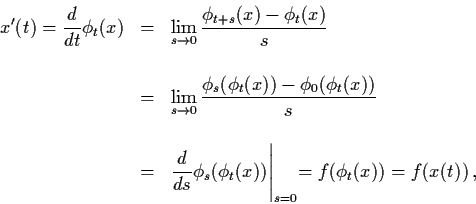In Section 2.5, we defined the (linear) flow
![]() ,
of the linear system
,
of the linear system
In this section, we define the (nonlinear) flow,
![]() ,
of the nonlinear system
,
of the nonlinear system
Let
![]() be an open set. Suppose
for any
be an open set. Suppose
for any
![]() system (3.12) admits a
unique solution
x(t, x0) existing on a maximal
interval J(x0). Then for any
system (3.12) admits a
unique solution
x(t, x0) existing on a maximal
interval J(x0). Then for any
![]() we define a mapping
we define a mapping
![]() by
by
Theorem 3.3.1: Let ![]() be the flow
associated with system (3.12). Suppose that for any
be the flow
associated with system (3.12). Suppose that for any
![]() ,
system (3.12) admits a unique
solution
x(t, x0) with
x(0, x0) =
x0. Then
,
system (3.12) admits a unique
solution
x(t, x0) with
x(0, x0) =
x0. Then ![]() satisfies
satisfies
Proof: (omitted)
Remark: The flow ![]() describes all
solutions of system (3.12) for all possible initial values
x0, and hence describes fully the evolution of
the physical system. For a fixed t,
describes all
solutions of system (3.12) for all possible initial values
x0, and hence describes fully the evolution of
the physical system. For a fixed t,
![]() gives the state of the system
gives the state of the system
![]() at time t for all initial
states x0. On the other hand, for a fixed
at time t for all initial
states x0. On the other hand, for a fixed
![]() ,
,
![]() gives the state of the system for all
gives the state of the system for all
![]() with
x(0) = x0 initially.
with
x(0) = x0 initially.
If we only abstract, from the differential system (3.12),
the one-parameter family of mappings ![]() which
satisfies property (i) and (ii), then we call
which
satisfies property (i) and (ii), then we call ![]() a dynamical system.
a dynamical system.
Definition 3.3.1: A dynamical system is a
C1 map
![]() which satisfies
which satisfies
Remark: Let ![]() be an open subset of
Rn. Then every dynamical system
be an open subset of
Rn. Then every dynamical system ![]() on
on ![]() gives rise to a differential equation.
In fact, define f by
gives rise to a differential equation.
In fact, define f by


Conversely, given differential system (3.12), its flow
![]() defined by (3.13) may define a dynamical
system. However, this converse process is much more
complicated. We still need to investigate the dependence
of the solutions of (3.12) on the initial value. To
establish dependence of the solution on initial values we
first give a result due to T.H. Gronwall, which is also of
independent interest.
defined by (3.13) may define a dynamical
system. However, this converse process is much more
complicated. We still need to investigate the dependence
of the solutions of (3.12) on the initial value. To
establish dependence of the solution on initial values we
first give a result due to T.H. Gronwall, which is also of
independent interest.
Lemma 3.3.1: (Gronwall) Suppose that m(t) is a continuous real valued function that satisfies
![]() and
and
![\begin{displaymath}m(t) \leq c + k \int_{0}^{t} m(s)ds \, ,\quad c, k>0 \,
,\quad t \in [0, \alpha ] \, .
\end{displaymath}](img515.gif)
Proof: (omitted)
Theorem 3.3.2: Let
![]() be
an open subset and f(x) satisfy a Lipschitz
condition on
be
an open subset and f(x) satisfy a Lipschitz
condition on ![]() ,
i.e.
,
i.e.
![]()
Proof: (omitted)
Theorem 3.3.3: Let
![]() .
Then the solution
x(t, x0) of (3.12) is
continuously differentiable at x0 for all
.
Then the solution
x(t, x0) of (3.12) is
continuously differentiable at x0 for all
![]() .
.
Proof: See L. Perko, P. 79-82.
Thus, given differential system (3.12) with
![]() ,
,
![]() being an open subset of
Rn. Then the flow
being an open subset of
Rn. Then the flow ![]() of (3.12) is a
dynamical system if an only if
of (3.12) is a
dynamical system if an only if
![]() ,
the solution of
x(t, x0) of
(3.12) is defined for all
,
the solution of
x(t, x0) of
(3.12) is defined for all ![]() ,
i.e.
,
i.e.
![]() .
In this case, we say
that
.
In this case, we say
that ![]() is the dynamical system on
is the dynamical system on
![]() defined by (3.12). The following definition
will be needed in the next section.
defined by (3.12). The following definition
will be needed in the next section.
Definition 3.3.2: Let
![]() .
Then E is called (i) a positively invariant set of
(3.12) if
.
Then E is called (i) a positively invariant set of
(3.12) if
![]() for all
for all ![]() ;
(ii) a negatively invariant set of (3.12) if
;
(ii) a negatively invariant set of (3.12) if
![]() for all
for all ![]() ;
(iii) an
invariant set if
;
(iii) an
invariant set if
![]() for all
for all ![]() .
.